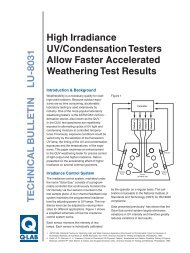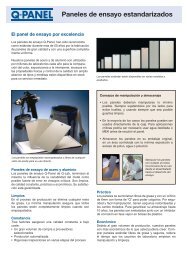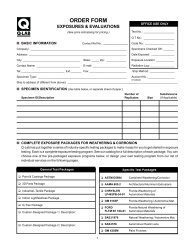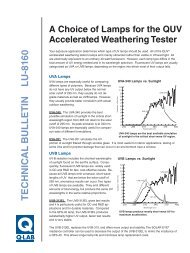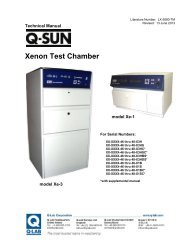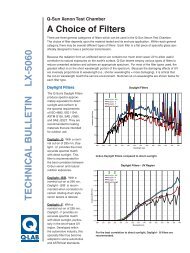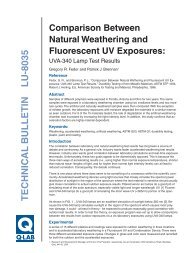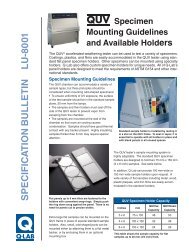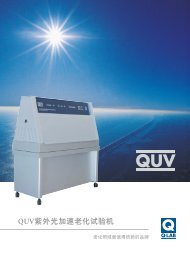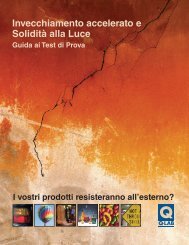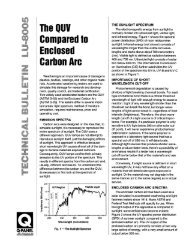Create successful ePaper yourself
Turn your PDF publications into a flip-book with our unique Google optimized e-Paper software.
<strong>Xenon</strong> <strong>Test</strong> <strong>Chambers</strong><br />
We make weathering simple.
Weathering Basics<br />
Sunlight, heat and moisture cause millions of<br />
dollars in product damage every year. Cracking,<br />
crazing, hazing, fading and yellowing can<br />
occur indoors or outdoors. With Q-SUN ® xenon<br />
test chambers, you can simulate the damage<br />
caused by full-spectrum sunlight, temperature<br />
and moisture. In just a few days or weeks, a<br />
Q-SUN tester can reproduce the damage that<br />
occurs over months or years outdoors.<br />
<strong>Xenon</strong> <strong>Test</strong>ers<br />
Q-SUN xenon test chambers are the<br />
ultimate research & development and<br />
quality control tool for testing materials<br />
that are exposed to direct sunlight,<br />
sunlight through window glass or indoor<br />
lighting. With a variety of models and<br />
options, you can customize your Q-SUN<br />
chamber to fit your testing needs.<br />
Three basic models suit the xenon<br />
testing needs of any lab: the tabletop<br />
Q-SUN Xe-1, the rotating rack Q-SUN<br />
Xe-2, and the large-capacity Q-SUN<br />
Xe-3. All models are full-featured weathering,<br />
lightfastness and photostability<br />
chambers and meet all major industry<br />
standards.<br />
Q-SUN test chambers are used by<br />
companies worldwide in dozens of different<br />
industries and applications to aid<br />
in the selection of new materials, the<br />
improvement of existing materials or the<br />
evaluation of how changes in formulation<br />
affect product durability.<br />
Will your product last outdoors? Don’t guess when you can test.<br />
2 www.q-lab.com
Why Q-SUN?<br />
Simple to Afford<br />
Simple to Use<br />
Simple to Maintain<br />
Q-SUN xenon arc testers were specifically<br />
designed to have the lowest total<br />
cost of ownership in the industry. Their<br />
low purchase price, low lamp price, and<br />
low operating costs set a new standard<br />
for lightfastness testing. Now even the<br />
smallest lab can afford xenon arc weathering<br />
and lightstability testing.<br />
Q-SUN xenon test chambers are easy<br />
to install, easy to program and easy<br />
to operate. Specimen mounting and<br />
evaluations are simplified with specially<br />
designed specimen holders. All models<br />
are completely automated and can operate<br />
continuously, 24 hours per day, 7<br />
days per week, without supervision. The<br />
testers are smart enough to alert you to<br />
problems they may encounter during<br />
testing.<br />
We believe that just because a product<br />
is technical, it doesn’t have to be hard<br />
to understand or difficult to maintain and<br />
repair. Instead of complicating our tester<br />
designs by loading them with extra or<br />
unnecessary features, we put our engineering<br />
effort into keeping things simple.<br />
Subsystems are modular, easy to troubleshoot<br />
and even easier to replace.<br />
This makes typical maintenance and<br />
repair of Q-SUN testers simple enough<br />
that it doesn’t require a field technician<br />
(but we’re here if you need us).<br />
Every feature of a Q-SUN tester was designed with simplicity in mind.<br />
www.q-lab.com<br />
3
Q-SUN Models<br />
Flat Array<br />
Q-SUN Xe-1<br />
Q-SUN Xe-3<br />
The Q-SUN Xe-1 is an economical,<br />
single-lamp tabletop tester with multiple<br />
capabilities. Its small scale is perfect<br />
for a lab with a limited budget or only<br />
an occasional need for testing. The<br />
Q-SUN Xe-1 tester’s slide-out specimen<br />
tray is 251 mm x 457 mm (9.88” x<br />
18”). Installation is simple and you can<br />
exhaust the Xe-1 directly into the room.<br />
The Q-SUN Xe-3 is a full-featured, fullsized<br />
tester at a breakthrough price. It<br />
utilizes three separate xenon lamps for<br />
larger capacity. This 451 x 718 mm<br />
(17.5” x 28”) specimen tray is almost<br />
three times larger than the Xe-1 and is<br />
useful for exposing large, three-dimensional<br />
parts or components.<br />
4 www.q-lab.com
Rotating Rack<br />
Q-SUN Xe-2<br />
The Q-SUN Xe-2 xenon tester offers a large-capacity rotating rack. It is often selected<br />
to meet some of the few remaining hardware-specific testing standards. It supports 31<br />
specimens of 46 mm x 122 mm (1.8” x 4.8”) each. Its single air-cooled lamp is more<br />
economical than water-cooled lamps, highly efficient and very low maintenance. The<br />
versatile Q-SUN Xe-2 tester is the simplest, most reliable, and easiest to use rotating<br />
rack xenon arc tester available.<br />
The Xe-2 tester’s rotating rack<br />
www.q-lab.com<br />
5
Key Features<br />
1<br />
Remarkably Simple<br />
User Interface<br />
2<br />
AUTOCAL<br />
Calibration<br />
3<br />
Full Spectrum<br />
<strong>Xenon</strong> Lamps<br />
The Q-SUN tester’s user interface<br />
is designed to be functional,<br />
highly reliable and easy to use. The<br />
controller allows for complete self-diagnostic<br />
error checking and can be<br />
programmed in 5 languages.<br />
More on page 12<br />
Q-<strong>Lab</strong>’s patented AUTOCAL ® technology<br />
makes user calibration of the<br />
Q-SUN tester’s on-board irradiance<br />
sensor fast and error-free. The handheld<br />
CR20 radiometer requires a<br />
yearly, inexpensive recalibration.<br />
More on page 13<br />
<strong>Xenon</strong> arc lamps produce the most<br />
realistic reproduction of full spectrum<br />
sunlight, including ultraviolet,<br />
visible light and infrared radiation.<br />
They are air-cooled, to maximize life<br />
while minimizing operating costs.<br />
More on page 8<br />
Long-Life<br />
Optical Filters<br />
Programmable<br />
Water Spray<br />
4 5<br />
6<br />
SOLAR EYE<br />
Irradiance Control<br />
A choice of optical filters is available<br />
to simulate a variety of service environments.<br />
Unlike many competing<br />
systems, Q-SUN optical filters last<br />
indefinitely under normal use.<br />
More on page 9<br />
Outdoor moisture attack is simulated<br />
via a pure water spray, an optional<br />
feature in all Q-SUN models. Spray<br />
can be programmed to operate during<br />
either the dark or light cycle.<br />
More on page 10<br />
The Q-SUN tester’s SOLAR EYE ®<br />
irradiance control system constantly<br />
monitors and controls lamp output to<br />
assure precise light exposure and to<br />
maximize repeatability and reproducibility<br />
of test results.<br />
More on page 9<br />
7<br />
Precision<br />
Temperature Control<br />
8<br />
Versatile<br />
Specimen Mounting<br />
9<br />
Relative<br />
Humidity Control<br />
All Q-SUN models control specimen<br />
temperature with a black panel<br />
(uninsulated) or a black standard<br />
(insulated) sensor. In the Xe-2 and<br />
Xe-3 models, chamber air temperature<br />
can be simultaneously controlled.<br />
More on page 11<br />
In the Xe-1 and Xe-3, the flat specimen<br />
mounting tray accommodates<br />
different shapes, sizes and types of<br />
three-dimensional specimens. The<br />
Xe-2 typically utilizes flat specimens.<br />
More on page 12<br />
Q-SUN Xe-2 and Xe-3 models feature<br />
precise control of relative humidity.<br />
This is often useful for testing interior<br />
materials, such as textiles, papers<br />
and inks.<br />
More on page 10<br />
6 www.q-lab.com
1<br />
2<br />
3<br />
4<br />
5<br />
6<br />
7<br />
8<br />
9<br />
Q-SUN testers aren’t loaded with unnecessary features — just the ones you need.<br />
www.q-lab.com<br />
7
Sunlight Simulation<br />
The Q-SUN testers’ xenon arc lamps produce<br />
the most realistic reproduction of full<br />
spectrum sunlight, including ultraviolet, visible<br />
light and infrared radiation. For many<br />
materials, exposure to the full spectrum is<br />
necessary to provide an accurate simulation,<br />
especially when testing for color change<br />
and lightfastness.<br />
Full-Spectrum <strong>Xenon</strong> Lamps<br />
Q-SUN xenon arc test chambers use air-cooled xenon arc lamps to significantly reduce<br />
operating and maintenance expenses. Lamp life is guaranteed at 1500 hours. Q-SUN<br />
models Xe-1 and Xe-2 use one lamp and model Xe-3 uses three.<br />
Changing lamps is quick and easy and does not interfere with the specimen exposure.<br />
In the Xe-1 and Xe-3, simply disconnect the plug, release one set screw and slide out<br />
the lamp housing. In the Xe-2, the lamp is easily accessible from the top of the tester.<br />
Replacement only requires the user to open an access door, release a set screw, and<br />
remove the trigger finger. The lamp and lamp housing can then be easily lifted out of<br />
the tester.<br />
The Q-SUN tester’s air-cooled xenon lamps maximize economy and ease of use.<br />
8 www.q-lab.com
Long-Life Optical Filters<br />
<strong>Xenon</strong> light must be properly filtered to<br />
achieve the appropriate spectrum for<br />
each particular application. Differences<br />
in spectra may affect both the speed<br />
and the type of degradation. Three categories<br />
of optical filters are available<br />
to simulate a variety of service environments.<br />
The application or test method<br />
dictates which filters should be used.<br />
Q-SUN optical filters are exceptionally<br />
durable and maintain the required spectrum<br />
indefinitely under normal use.<br />
For the Q-SUN Xe-1 and Xe-3, filters<br />
consist of a single pane of specially formulated<br />
glass. The Q-SUN Xe-2 tester’s<br />
optical lanterns consist of an outer borosilicate<br />
or quartz glass cylinder and two<br />
sets of 7 durable inner filters, arranged in<br />
a two-tier heptagon.<br />
Daylight Filters<br />
Daylight filters are used to simulate direct sunlight.<br />
They provide the best correlation to natural outdoor<br />
exposures for most applications. Materials that<br />
are typically used outdoors like roofing or exterior<br />
coatings should be tested using daylight filters.<br />
Three different types of daylight filters are available<br />
for Q-SUN xenon test chambers: Daylight – F,<br />
Daylight – Q and Daylight - B/B.<br />
Window Glass Filters<br />
Window glass filters produce spectra equivalent to sunlight coming through<br />
window glass. This spectrum can also simulate other indoor lighting such as the harsh<br />
lighting found in a typical commercial or office environment. Window glass filters are<br />
used for indoor materials such as printing materials or textiles. Four different window<br />
glass filters are available: Window - Q, Window - B/SL, Window SF-5 and Window - IR.<br />
Extended UV Filters<br />
Extended UV filters allow excess UV, below the normal cut-on of natural sunlight.<br />
They are used to produce faster or more severe test results. Extended UV filters are<br />
specified in some automotive test methods and are sometimes used for aerospace<br />
applications. There are two available Q-SUN filters of this type: Extended UV - Q/B<br />
and Extended UV - Quartz.<br />
SOLAR EYE Irradiance Control<br />
All Q-SUN xenon test chambers are equipped with SOLAR EYE irradiance control, a<br />
patented, precision light control system. The SOLAR EYE system allows the user to<br />
choose the desired level of irradiance. It automatically monitors and maintains the<br />
programmed light intensity. Irradiance is monitored and controlled at 340 nm, 420 nm<br />
or TUV.<br />
The Xe-2 optical filter lantern<br />
www.q-lab.com<br />
9
Environmental Simulation<br />
Moisture<br />
Moisture, such as water spray, condensation<br />
and humidity is critical for testing many<br />
materials. All Q-SUN models are available<br />
with optional water spray and both the Xe-2<br />
and Xe-3 models offer standard control of<br />
relative humidity.<br />
Water Spray Relative Humidity Water Purity<br />
The damaging effects of outdoor moisture<br />
attack are simulated by direct,<br />
pure water spray. The spray can be<br />
programmed to operate during either<br />
the light or dark periods and can be<br />
useful for creating thermal shock and/or<br />
mechanical erosion.<br />
The Q-SUN Xe-2 and Xe-3 models are<br />
available with relative humidity control.<br />
Humidity can affect degradation<br />
when the material becomes physically<br />
stressed while attempting to maintain<br />
moisture equilibrium with its<br />
surroundings. Relative humidity also<br />
influences the rate at which a specimen<br />
dries. Controlled humidity is required in<br />
a number of widely used test methods.<br />
In Q-SUN testers with water spray, highly<br />
purified deionized water is necessary<br />
to prevent water spotting. Suspended<br />
silica is the major cause of specimen<br />
spotting. Recommended specifications<br />
are
Temperature<br />
Control of temperature is important because<br />
it significantly influences the rate of degradation.<br />
Specimen exposure temperature is<br />
precisely controlled in all Q-SUN xenon chambers<br />
using a black panel temperature sensor.<br />
Black Panel Chamber Air Lower Temperatures<br />
A black panel thermometer is used to<br />
control temperature in the Q-SUN test<br />
chamber. Due to its black coating which<br />
absorbs all wavelengths uniformly, it<br />
provides an estimate of the maximum<br />
temperature of specimens in the chamber.<br />
Black panel temperature can be set<br />
at any point between 25ºC and 120ºC<br />
(77ºF to 248ºF) depending upon the irradiance<br />
level, lamp age, ambient room<br />
temperature, black panel sensor and<br />
specific tester model. Both insulated or<br />
uninsulated sensors (black standard or<br />
black panel) are available.<br />
In both the Q-SUN Xe-2 and Xe-3<br />
models, chamber air can also be controlled<br />
simultaneously with black panel<br />
to give the ultimate control of specimen<br />
temperature. The low-cost, disposable<br />
sensor also monitors and controls relative<br />
humidity. In the Xe-1, chamber<br />
air or black panel temperature must<br />
be selected.<br />
For some interior products such as<br />
pharmaceuticals and cosmetics, lower<br />
exposure temperatures are necessary<br />
to prevent unnatural degradation. An<br />
optional chiller is available for these<br />
applications. See page 14<br />
An optional chiller is available for applications requiring low exposure temperatures.<br />
www.q-lab.com<br />
11
Operation<br />
Q-SUN xenon test chambers are extremely<br />
simple to operate. Specimen mounting<br />
and evaluations are simplified with specially<br />
designed specimen holders. Programming<br />
is intuitive. All models are completely automated<br />
and can operate continuously, 24<br />
hours per day, 7 days per week.<br />
Specimen Mounting Programming Standards<br />
Specimens exposed in a Q-SUN Xe-1<br />
and Xe-3 are mounted in a nearly horizontal<br />
orientation. This flat specimen<br />
mounting system offers the flexibility<br />
to test many sizes, shapes and types<br />
of specimens.<br />
The Q-SUN Xe-2 rotating rack positions<br />
specimens vertically. This configuration<br />
is ideal for testing thin, flat specimens<br />
such as textiles, paints and coatings.<br />
Designed to be both functional and<br />
easy to use, the Q-SUN controller can<br />
be programmed in five user-selectable<br />
languages (English, French, Spanish,<br />
Italian or German). Users can program<br />
and store up to 10 tests in memory,<br />
which has a battery back-up feature.<br />
Every Q-SUN tester goes through extensive<br />
acceptance testing with a test<br />
standard of your selection, which is<br />
pre-loaded into memory. This includes<br />
weathering and lightfastness standards<br />
from ISO, ASTM, SAE, AATCC, IEC, GM<br />
and VW, just to name a few.<br />
Standard holders are available in a<br />
number of sizes to accommodate a<br />
variety of different specimens. Bottle<br />
holders, textile holders and special<br />
mountings are also available.<br />
12 www.q-lab.com
Calibration & Maintenance<br />
Q-SUN chambers are equipped with a<br />
number of on-board sensors to monitor and<br />
control the environment inside the chamber.<br />
All Q-SUN sensors need to be calibrated or<br />
replaced periodically to ensure accurate and<br />
consistent results. This process is simple and<br />
inexpensive in a Q-SUN tester.<br />
Irradiance<br />
Temperature<br />
Relative Humidity<br />
The Q-SUN tester’s on-board SOLAR<br />
EYE irradiance sensor needs to be calibrated<br />
periodically by the user to assure<br />
accurate and consistent results.<br />
Calibrating the Q-SUN tester is simple<br />
using a CR20 calibration radiometer, and<br />
takes only a few minutes. Note that the<br />
CR20 comes with a 340 nm, 420 nm, or<br />
300-400 nm TUV (Total UV) sensor. This<br />
sensor must match the type of sensor<br />
and filter type actually used in the<br />
Xe-3 tester.<br />
The CR20 radiometer needs to be<br />
returned to Q-<strong>Lab</strong> once per year for an<br />
inexpensive recalibration. Our recalibration<br />
labs are accredited by A2LA and<br />
UKAS for ISO 17025.<br />
The Q-SUN tester’s black panel temperature<br />
sensor and optional chamber<br />
air temperature sensor also need to be<br />
calibrated periodically by the user.<br />
Calibrating the black panel temperature<br />
sensor is simple using a CT202 thermometer,<br />
and takes only a few minutes.<br />
Note that the CT202 thermometer comes<br />
with either an uninsulated black panel<br />
(CT202/BP) or insulated black panel<br />
(CT202/IBP) sensor. This sensor must<br />
match the type of sensor actually used<br />
in the Xe-1 tester. The chamber air temperature<br />
sensor in an Xe-2 and Xe-3 is<br />
inexpensive and requires replacement<br />
once per year.<br />
The CT202 thermometer needs to be<br />
returned to Q-<strong>Lab</strong> once per year for an<br />
inexpensive recalibration.<br />
RH control is available in Xe-2 and Xe-3<br />
models. These models simultaneously<br />
control, monitor and display relative<br />
humidity, black panel temperature and<br />
chamber air temperature.<br />
Maintenance<br />
The Q-SUN controller includes complete<br />
self-diagnostic error checking. The controller<br />
constantly monitors the status and<br />
performance of all systems. It also displays<br />
simple warning messages, routine<br />
maintenance reminders and performs<br />
safety shutdown, as needed.<br />
Typical maintenance items are lamps,<br />
sensor calibrations and inexpensive<br />
air filters.<br />
www.q-lab.com<br />
13
Accessories & Options<br />
Specimen Holders<br />
Chiller<br />
Water Repurification<br />
Holders are available in a number of<br />
sizes to accommodate traditional flat<br />
specimens, like panels and plaques.<br />
Bottle holders, textile holders and special<br />
mountings are also available for the<br />
Q-SUN Xe-1 and Xe-3. 3-D specimens<br />
can be placed directly on the specimen<br />
tray and in most cases do not require a<br />
specimen holder.<br />
A chiller is available for both the Xe-1<br />
and Xe-3. It is used to lower temperatures<br />
when testing temperature-sensitive<br />
materials. The Xe-1 with chiller is configured<br />
so that the chiller is essentially<br />
a “permanent stand” for the tester. For<br />
an Xe-3, the chiller is a separate unit that<br />
requires additional floor space.<br />
Unlike competing systems that simply<br />
recirculate dirty water, Q-<strong>Lab</strong>’s repurification<br />
system repurifies water in addition<br />
to conserving it. Due to the high cost of<br />
purified water, the system can pay for<br />
itself in a matter of months.<br />
Dual Spray<br />
Ponding Kit<br />
Back Spray<br />
Dual spray is available for the Xe-3 only.<br />
It allows a second liquid solution, such<br />
as an acid rain or soap solution, to be<br />
sprayed onto test specimens. The<br />
system consists of a large external reservoir,<br />
centrifugal pump and a filter.<br />
Some industry standards require not just<br />
water spray, but water immersion. Q-<strong>Lab</strong><br />
offers a standard ponding kit which is<br />
coupled with our water repurification<br />
system for maximum cost effectiveness.<br />
Back spray is required by some SAE<br />
test methods; it allows water to be<br />
sprayed on both the front and back side<br />
of specimens simultaneously. This configuration<br />
is ideal for use with a water<br />
repurification system.<br />
14 www.q-lab.com
Summary<br />
4 Standard 2 Optional<br />
Feature Xe-1 Xe-2 Xe-3<br />
Chamber Type Flat Array Rotating Rack Flat Array<br />
Specimen Capacity 17 31 55<br />
Specimen Orientation 10° 90° 10°<br />
3D Specimen Capability 4 – 4<br />
Full Spectrum <strong>Xenon</strong> Arc Lamps 1 1 3<br />
Long-Life Optical Filters 4 4 4<br />
SOLAR EYE Irradiance Control (340 nm, 420 nm or TUV) 4 4 4<br />
Black Panel Temperature Control 4 4 4<br />
Chamber Air Temperature Control 2 4 4<br />
Relative Humidity Control – 4 4<br />
AUTOCAL Calibration 4 4 4<br />
Programmable Water Spray 2 2 2<br />
CR20 Calibration Radiometer 2 2 2<br />
CT202 Black Panel Thermometer 2 2 2<br />
Water Repurification System 2 2 2<br />
Chiller 2 – 2<br />
Ponding Kit 2 –<br />
2<br />
Dual Spray – – 2<br />
Back Spray – – 2<br />
Our Other Products and Services<br />
0859-01 & 0859-03<br />
Accelerated<br />
Weathering <strong>Test</strong>ers<br />
Cyclic<br />
Corrosion <strong>Test</strong>ers<br />
Standard<br />
<strong>Test</strong> Substrates<br />
Outdoor<br />
Exposure <strong>Test</strong>ing<br />
Sunlight<br />
Concentrator <strong>Test</strong>ing<br />
<strong>Lab</strong>oratory<br />
Contract <strong>Test</strong>ing<br />
Outdoor<br />
Exposure Racks<br />
www.q-lab.com<br />
15
Our Global Network<br />
Q-<strong>Lab</strong> headquarters are located in Westlake, Ohio USA, with sales and distribution facilities located in England, Germany, and<br />
China. Our A2LA-accredited laboratory facilities are located in Germany, Florida and Arizona. We also maintain outdoor exposure<br />
facilities in Florida, Arizona and Ohio. We support our customers through direct salespersons and distributors in over 60<br />
countries, across 6 continents.<br />
Q-<strong>Lab</strong> Corporation<br />
www.q-lab.com<br />
Q-<strong>Lab</strong> Headquarters<br />
Westlake, OH USA<br />
Tel: +1-440-835-8700<br />
info@q-lab.com<br />
Q-<strong>Lab</strong> Europe, Ltd.<br />
Bolton, England<br />
Tel: +44-1204-861616<br />
info.eu@q-lab.com<br />
Q-<strong>Lab</strong> Deutschland GmbH<br />
Saarbrücken, Germany<br />
Tel: +49-681-857470<br />
vertrieb@q-lab.com<br />
Q-<strong>Lab</strong> Florida<br />
Homestead, FL USA<br />
Tel: +1-305-245-5600<br />
q-lab@q-lab.com<br />
Q-<strong>Lab</strong> Arizona<br />
Buckeye, AZ USA<br />
Tel: +1-623-386-5140<br />
q-lab@q-lab.com<br />
Q-<strong>Lab</strong> China 中 国 代 表 处<br />
Shanghai, China 中 国 上 海<br />
电 话 : +86-21-5879-7970<br />
info.cn@q-lab.com<br />
LX-5000.6 © 2013 Q-<strong>Lab</strong> Corporation. All Rights Reserved. Q-<strong>Lab</strong>, the Q-<strong>Lab</strong> logo, Q-SUN, QUV, Q-FOG, Q-PANEL, Q-TRAC, Q-RACK, AUTOCAL and SOLAR EYE are registered trademarks of Q-<strong>Lab</strong> Corporation.



